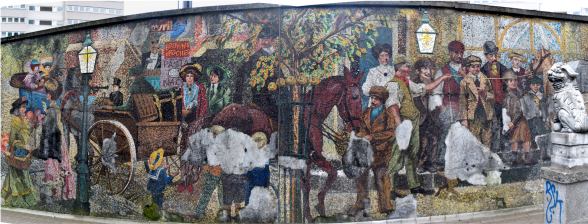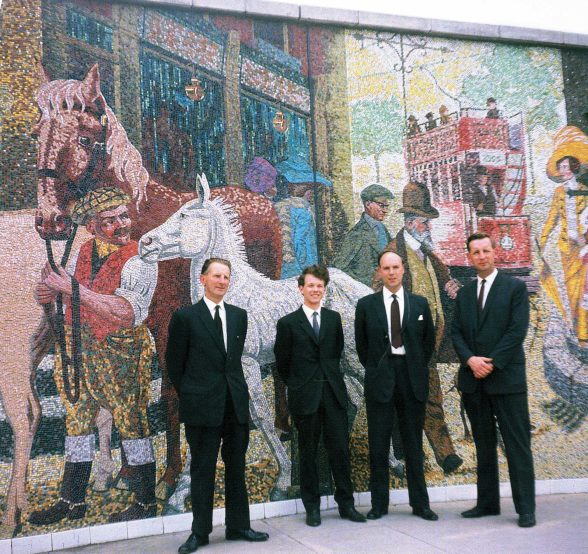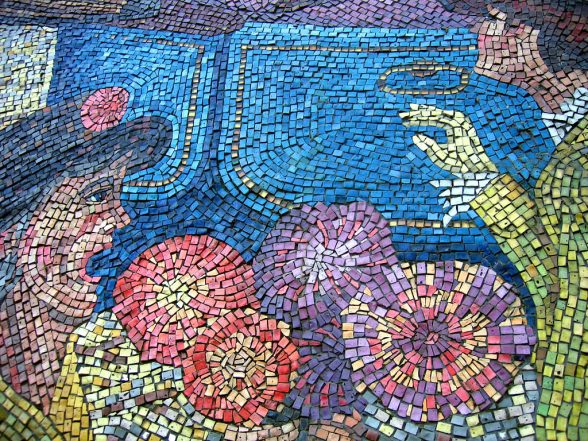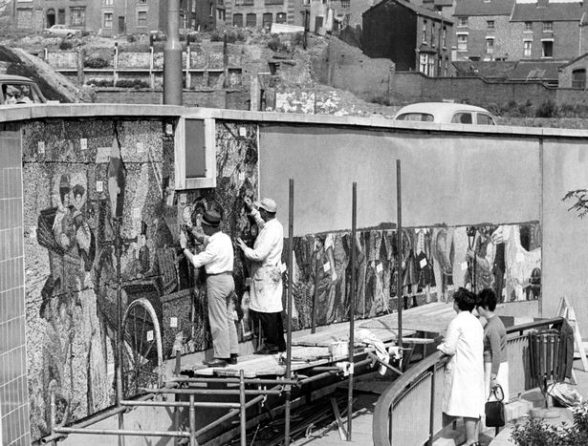This website uses cookies
This website uses cookies to enable it to function properly and to analyse how the website is used. Please click 'Close' to accept and continue using the website.



Image: Manoo Mistry
C20 has applied to list an 85ft long mural at Holloway Circus roundabout, on Birmingham’s Inner City Ringroad, following concerns around its deteriorating condition and uncertain future. The Horse Fair mural was created by artist Kenneth Budd in 1966 and depicts the centuries old custom of trading horses in the area. There were originally 6 artworks by Budd throughout the city; this is the last one that survives in its original position.
The Society intervened following reports that Birmingham City Council planned to ‘decommission’ the mosaic due to its poor condition. A credible report commissioned by the council in 2021 claims that “in situ repair would not be viable” and recommended one of several options (below). The council has stated that it plans to consult on the best way forward.
In descending order of estimated cost:

Image: Kenneth Budd Archive
It is the Society’s view that this is a technically ambitious and exceptionally skillful work, executed by a master mosaicist. As an important example of post-war public art, we are concerned that the mosaic could be lost if any recreation is poorly executed.
Listing the mural would help to ensure that the artwork is properly documented, removed, restored and reinstalled. This approach has been successful in other cases, notably the Dorothy Annan murals (c.1960), which were listed Grade II in 2011, then carefully removed from the Fleet Building and re-listed in their new location at the Cromwell Highwalk at the Barbican in 2016.
History
Unveiled by The Lord Mayor of Birmingham Alderman H. E Tyler J.P. on June 30, 1966 the mural is located on the western side of Thomas Gardens in the Holloway Circus roundabout. The roundabout was built at the top of Smallbrook Queensway (formerly Smallbrook Ringway) as part of the Inner Ring Road development, built between 1957 and 1970. The mural depicts activities in the Horse Fair which took place in this area until 1911, and was the last remaining fair of the charter granted by Henry III in 1215.
The site also once accommodated a statue of Hebe (1966), which was designed by Les Howles of the city architect’s department then sculpted and cast in bronze by J.R. Thomas. In 2005, the statue was reported as being “in store”. The roundabout was re-landscaped in 1998 by Birmingham Design Services and a Chinese pagoda installed.
Design
The Horse Fair mural measures 86ft in length and 13ft in height – totalling just over 100sqm of mosaic. Budd split the mural into 4 sections and worked on the mosaic with his colleague Alan Kemp and former student Paul Fink. They used Venetian ‘smalti’ – highly coloured Italian glass, produced in small pieces from larger slabs and designed for mosaic use because it enables fine detail.
The mosaic is a remarkable large-scale work which is bold and colourful but also includes fine and intricate detail. Horses and figures are carefully picked-out and faces are expressive and animated. As recorded in an article by Professor Carl Chinn, among those who came to watch the work being installed was a man who ran a horse and carriage wedding service. The man identified the types of horses and said that “his old dad who remembered the old Horse Fair would vouch for the authenticity of the work”.
The wall at Holloway Circus was prepared with cement render, then covered with adhesive and the mosaic panels installed one section at a time, secured with Hilte gun fixings. After the sections had been affixed, any gaps between them were filled with additional smalti. This was followed by grouting with Bal-grout cement powder, which was coloured grey to match the shadows between ungrouted tessera. Finally it was washed with diluted solution of spirits of salts, to remove any grout film remaining and hosed with clean water. Once dry, it was treated with two applications of a silicon solution to aid the prevention of water penetration.
However, over the intervening 50 years the mural has indeed suffered from water ingress and damp, with patch repairs failing to address the deterioration in its condition. This has hastened in recent years, with an estimated 15% of the mosaic now lost. Sympathetic cleaning, digital recording and careful relocation or reinstallation would ensure this historically important artwork can be saved for future generations.

Image: Tim Riches
Kenneth Budd
The artist Kenneth Budd trained at the Royal at the Royal College of Art in mural design and painting under Kenneth Rowntree, graduating in 1951. He joined the firm of William Mitchell and Partners in 1961 when this firm was pioneering art for public spaces and buildings and confirming Mitchell’s status as a leading post-war British muralist and sculptor.
Budd assisted Bill Mitchell in a mural for Derby College of Technology and cast concrete bas-reliefs for the London Boroughs of Lewisham and Wandsworth. At this time Budd developed the use of polychromatic glass mosaic in murals, based on Italian techniques, thereby replacing the traditional painted form which was difficult to make weatherproof in England. Following his work in the mid-1960s with the William Mitchell Studio on the so-called Civil War Mosaic and the Industrial Mosaic for Birmingham City Council (both now destroyed), Budd went out on his own and in 1968-69 secured contracts for two huge mosaics in Birmingham at St Chad’s Circus, the John F Kennedy Memorial mosaic and the Great Western Railway Mosaic.
St Chads Circus was redeveloped and the Kennedy mural dismantled in 2007. Kenneth’s son, Oliver, recreated the mosaic in a new location, on the corner of Deritend High Street and Floodgate Street in Digbeth. Some sections of the Great Western Railway mural were removed but most was buried on site.
In the 1970s, Budd was commissioned by Newport City Council to produce two mosaics, the Chartist Mural and the Monmouthshire Railway and Canal Company Mural, and cast concrete bas reliefs for the Inner Ring Road. The Chartist Mural was destroyed in 2013, following a rejected listing application by C20. Much of Budd’s work has been lost and none yet listed, making the Horse Fair mosaic an important and rare surviving work by a major post-war British mosaic artist.

Image: Kenneth Budd Archive

Become a C20 member today and help save our modern design heritage.